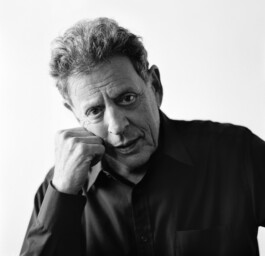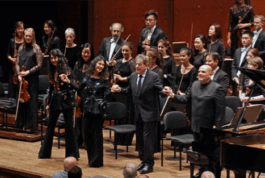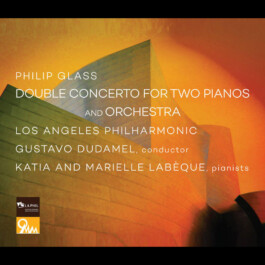Philip Glass—
Double Piano Concerto

“Like many people involved in today’s music I have long been an admirer of Katia and Marielle Labèque’s performance of traditional and new concert music for duo pianos. I was very happy to hear their brilliant playing and interpretative skills with my own music – first with the 2007 work, Four Movements for Two Pianos and then, more recently, the Two Movements for Four Pianos.
The work itself follows the three movement form in which many concertos are conceived. However in this case the first and second movements are both fast and the slow movement is the third and last part of the concerto.
Also it seemed that there were enough ‘fireworks’ in the first two movements as to make an additional cadenza for the soloists unnecessary. Again the relationship of the soloist to the orchestra is not the usual one, contrasting the smaller duo with the larger orchestral ensemble. Instead the music of the soloists is shared between the two and the orchestra serves to extend the range and color of the soloists.”
—Philip Glass
Katia & Marielle Labèque - Philip Glass Double Concerto for two pianos
Four Movements
Philip Glass Comes, Finally, To The New York Philharmonic
NEW YORK TIMES
ANTHONY TOMMASINI
26.09.2017
With these performances of the Glass concerto, featuring the splendid pianists Katia and Marielle Labèque as soloists, Mr. van Zweden has filled a gaping hole in the Philharmonic’s history. Overlooking Mr. Glass’s work had to have been a deliberate choice by a succession of music directors, because, love him or hate him, he has been an influential figure in contemporary classical music for some 40 years.
And this 27-minute concerto in three movements, which had its premiere in 2015 with the Los Angeles Philharmonic, is inventive and unusual. The orchestra starts off abuzz with rippling, subdued riffs. Almost immediately the pianos, backed by various instruments, play a slippery theme in chords that dip and rise almost step by step.
The music is fidgety and full of harmonic shifts, run through with two-against-three rhythms. There’s a mellow, jazzy quality at play: Imagine Gershwin as a Minimalist.
Most concertos have combative passages between the soloist and orchestra. Not this one. The pianists and orchestra are like allies, and that quality persists in the darker second movement, which has long stretches in which two-note motifs keep oscillating and you can’t decide whether the mood is soothing or ominous. The pianists, like trusted guides, take the orchestra (and listeners) through a pulsing thicket of music.
There are moments when what sounds like an echo of that slippery opening theme emerges: The pianos try to catch hold of the tune and pin it down. Mr. Glass ends his concerto with a wistful slow movement. Recurring figures in triplets hover in the pianos, while a sighing, spare melody floats above in bare octaves.
The piano parts, though not showy, are detailed and difficult. The Labèque sisters played a scintillating and elegant performance, and Mr. van Zweden nicely conveyed the mix of sassiness and delicacy in the music.
NY PHILHARMONIC OPENS ITS SEASON WITH MAHLER AND GLASS UNDER THE SURE BATON OF VAN ZWEDEN
CHRISTOPHER JOHNSON
25.9.2017
Glass’ Concerto for Two Pianos and Orchestra(2015, revised 2016) received its New York premiere, featuring the Labèque sisters, for whom it was written. It’s an attractive and absorbing piece, with more event than you might expect, and far more in the way of external reference than Glass usually gives away: I felt the Ravel G-major concerto whispering behind the second movement, and the slow wind-down of the opening movement distinctly evokes Shostakovich, whom Glass greatly admires. The Labèques played it with absolute commitment and beauty of tone, and van Zweden conducted with real feeling, so that it came over with moment-by-moment inflections that often go missing in more poker-faced specialist readings.

“The 'Enfants Terribles Suite' that followed proved, to my surprise, the evening’s masterpiece. ..... The Labèques played it with devout objectivity. While each section illustrates the moods and actions of scenes in the narrative, the work overall becomes a subtly and enchantingly poetic series of études. Here and there are echoes of many older composers (Beethoven, Chopin, Debussy) – yet they’re incidental. This music is an open-sesame of affecting rhythmic structures and intensely atmospheric pianistic colours. I want to call it the finest of the many Glass compositions I’ve heard; I congratulate Riesman on the glorious sensitivity to pianistic sound he conjures here.”
—Norman Lebrecht October 22, 2021 Slippedisc.com
“The Labèques and everything Philip Glass were the highlights of this Philharmonia performance”
—22/10/2021 COLIN CLARKE - Seen & Heard International

PHILIP GLASS — DOUBLE CONCERTO FOR 2 PIANOS
« In the double concerto I was aiming for a very different dynamic than one hears in the big Romantic-era repertoire. The 19th century concertos were kind of showdown between the orchestra and the soloists. But I saw the orchestra instead as being an extension of the piano- even more extended, because here you have two pianos. I don’t want those 176 keys to dominate. In this piece that balance is critical and difficult. I want them to blend into each other. So this concerto is not for amateurs. You’ve got to be on your toes »
—Philip Glass
Grammy winners Gustavo Dudamel and the Los Angeles Philharmonic, along with pianists Katia and Marielle Labéque, released the world-premiere recording of Philip Glass' newest concert work, his Double Concerto for Two Pianos and Orchestra on Orange Mountain Music exclusively on iTunes. The digital-only recording is also available.
Recorded during its world premiere at Walt Disney Concert Hall in Los Angeles in May 2015, Glass' Double Concerto for Two Pianos and Orchestra was composed for soloists Katia and Marielle Labéque in the fall and winter of 2014-15 and commissioned by the Los Angeles Philharmonic, Orchestre de Paris, Borusan Istanbul Philharmonic Orchestra, Göteborgs Symfoniker and Orquesta Nacional de España.